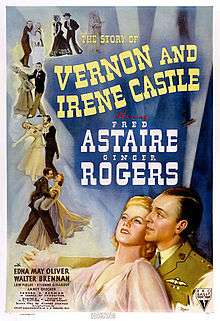The Story of Vernon and Irene Castle
| The Story of Vernon and Irene Castle | |
|---|---|
 Theatrical release poster | |
| Directed by | H. C. Potter |
| Produced by | George Haight |
| Screenplay by |
Richard Sherman Oscar Hammerstein II Dorothy Yost |
| Story by | Irene Castle |
| Starring |
Fred Astaire Ginger Rogers Edna May Oliver Walter Brennan |
| Music by | Various[1] |
| Cinematography | Robert de Grasse |
| Edited by | William Hamilton |
| Distributed by | RKO Radio Pictures |
Release dates |
|
Running time | 93 minutes |
| Country | United States |
| Language | English |
| Budget | $1,196,000 (est.)[3][4] |
| Box office | $1,825,000[4] |
The Story of Vernon and Irene Castle is an American biographical musical comedy, released in 1939 and directed by H.C. Potter. The film stars Fred Astaire, Ginger Rogers, Edna May Oliver, and Walter Brennan.[5] The movie is based on the stories My Husband and My Memories of Vernon Castle, by Irene Castle. The movie was adapted by Oscar Hammerstein II, Dorothy Yost and Richard Sherman.
Plot
The film tells of novice American dancer Irene Foote (Ginger Rogers) who convinces New York-based British vaudeville comic Vernon Castle (Fred Astaire) to give up slapstick comedy in favor of sophisticated ballroom dancing.
Their big break comes when they are stranded in Paris, along with their friend Walter Ashe (Walter Brennan), with no money. They catch the eye of influential agent Maggie Sutton (Edna May Oliver), who arranges a tryout for them at the prestigious Café de Paris, where they become an overnight sensation. After taking Europe by storm, the Castles return to the United States and become just as big a sensation. Their fame and fortune rises to unprecedented heights in the immediate pre-World War I years.
When World War I starts, Vernon returns to Britain and joins the Royal Flying Corps, while Irene makes patriotic movie serials to aid the war effort. However, Vernon is killed in a training accident, leaving Irene to carry on alone.
Cast
- Fred Astaire as Vernon Castle
- Ginger Rogers as Irene Castle (née Foote)
- Edna May Oliver as Maggie Sutton
- Walter Brennan as Walter Ash
- Lew Fields as Himself
- Etienne Girardot as Papa Aubel
- Janet Beecher as Mrs. Foote
- Rolfe Sedan as Emile Aubel
- Leonid Kinskey as Artist
- Robert Strange as Dr. Hubert Foote
- Douglas Walton as Student Pilot
- Clarence Derwent as Papa Louis
- Sonny Lamont as Charlie, Tap Dancer
- Frances Mercer as Claire Ford
- Victor Varconi as Grand Duke
- Donald MacBride as Hotel Manager
- Leyland Hodgson as British Sergeant
Production
Irene Castle acted as advisor to this film, and constantly disagreed with the director as to details of costuming and liberties taken. When informed that white actor Walter Brennan was to play the part of faithful servant Walter, she was dumbfounded: the real Walter was black.[6]
The film marks several "firsts": the characters in it are more realistic than usual in an Astaire-Rogers film, there is none of the usual "screwball comedy" relief provided by such actors as Edward Everett Horton, Victor Moore, or Helen Broderick, it is the only Astaire-Rogers musical biography, the only one on which Oscar Hammerstein II worked, the only one of their musicals with a tragic ending, and the only one in which Astaire's character dies.
Reception
The film was popular in the US, making $1,120,000 and it also earned $705,000 elsewhere. However, due to high costs RKO accounts recorded the movie as losing $50,000.[4]
Footnotes
- ↑ Reel Classics: The Story of Vernon and Irene Castle Retrieved 2013-01-07
- ↑ "The Story of Vernon and Irene Castle: Detail View". American Film Institute. Retrieved April 12, 2014.
- ↑ IMDb: Box office / business for The Story of Vernon and Irene Castle Retrieved 2013-01-07
- 1 2 3 Richard Jewel, 'RKO Film Grosses: 1931-1951', Historical Journal of Film Radio and Television, Vol 14 No 1, 1994 p41
- ↑ Story of Vernon and Irene Castle at the Internet Movie Database.
- ↑ The Story of Vernon and Irene Castle at AllMovie.
External links
- The Story of Vernon and Irene Castle at the Internet Movie Database
- The Story of Vernon and Irene Castle at AllMovie
- The Story of Vernon and Irene Castle at Rotten Tomatoes
- The Story of Vernon and Irene Castle at the Reel Classics web site; contains plot detail.